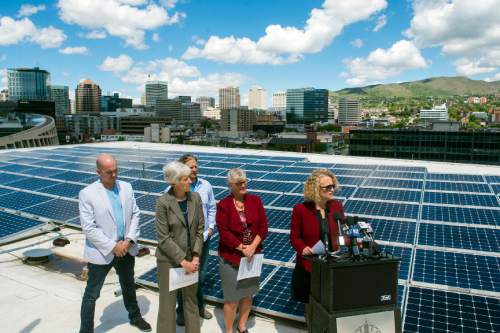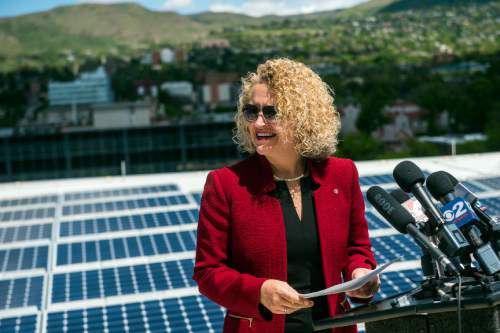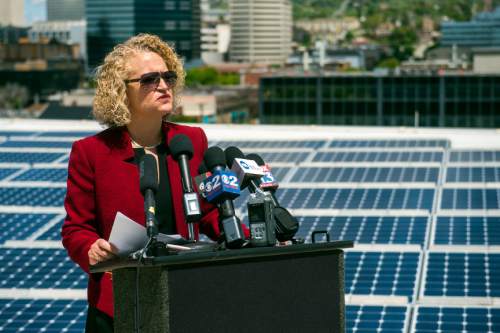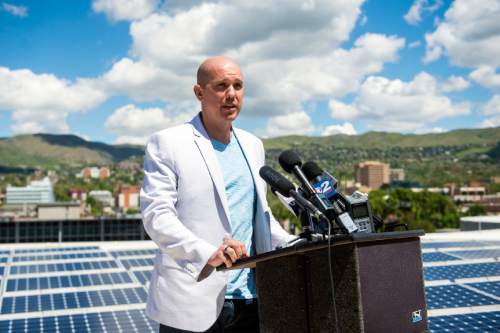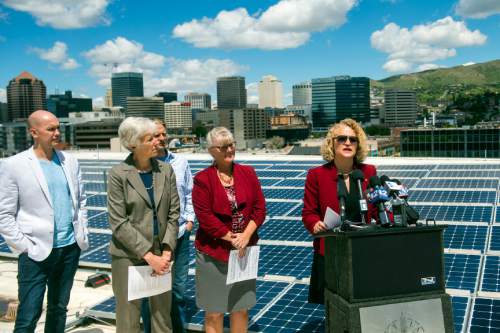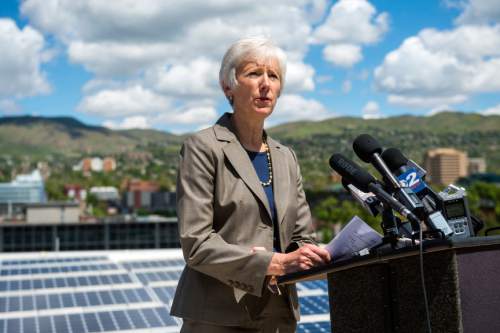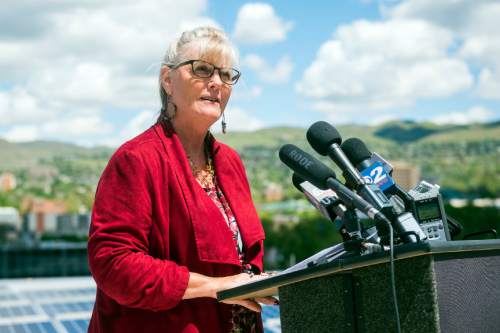This is an archived article that was published on sltrib.com in 2016, and information in the article may be outdated. It is provided only for personal research purposes and may not be reprinted.
Rocky Mountain Power believes it has finally found a way to get Utah customers the cheap renewable energy they've been asking for, but local leaders are concerned that the deal would give California authority over Utah and 10 other Western states.
The utility is exploring the creation of a regional grid management system that would redistribute electricity in 11 Western U.S. states, a deal that Rocky Mountain Power says would lower customers' costs and give them greater access to renewable energy.
Local critics, including Utah Gov. Gary Herbert, are skeptical. They argue that, barring radical change, the agreement would benefit California at the expense of Utah independence.
The grid's presumptive manager — the California Independent System Operator (CAISO), an independent nonprofit that oversees electrical transmission in California — is led by a board of governors appointed by California's governor and Legislature.
"While it is clear that California's energy agencies and the CAISO are ambitiously pursuing a path for PacifiCorp's participation in a new regional transmission organization, it is not clear whether such a development would be in Utah's best interest," Herbert wrote in a March 2 letter to California Gov. Jerry Brown.
A 2015 study commissioned by CAISO and PacifiCorp — which operates as Rocky Mountain Power in Utah, Wyoming and Idaho and as Pacific Power in Oregon, Washington and California — says that a regional grid would save PacifiCorp customers as much as $272 million by 2030.
But there are costs that aren't being considered, said Michele Beck, director of the Utah Office of Consumer Services.
"The study made it sound like we would be stupid not to go out and get those benefits," she said. "Well, no, it's not. It's not smart to talk about benefits when we aren't sure of the costs."
—
California is solar power country, so much so that some afternoons, the state's solar arrays generate more electricity than residents use. But those same arrays don't generate enough power later in the day, when demand peaks, forcing the state to continue to rely on nonrenewable resources.
In late 2014, PacifiCorp and CAISO entered into an agreement, called the Joint Energy Imbalance Market, to address this situation. Partners in the market — currently CAISO, all of PacifiCorp and Nevada's NV Energy — can buy and sell power across their systems in real time. When California has a surplus of solar power, it might sell it on the cheap to Utah, which has peak demand at about the same time solar power production surges on the coast.
In its first eight months of operation, the energy market generated an estimated $21 million in savings for PacifiCorp customers, according to a 2015 study commissioned by PacifiCorp and CAISO.
Encouraged by those results, power companies in Washington and Arizona have pledged to join the energy market this year. Portland General Electric intends to sign on by October 2017, and Idaho Power has committed to join in October 2018, according to Oscar Hidalgo, CAISO's director of communications.
And PacifiCorp and CAISO believe there is even greater potential for cost savings in full grid integration, which would allow participating utilities to plan for peaks in supply and demand by concentrating transmission oversight in a single entity — most likely CAISO, because it's the only entity in the West set up to assume such a position, Hidalgo said.
According to the 2015 study, PacifiCorp customers stand to save a combined $200 million to $272 million by the year 2030 on a regional grid system. Customers of CAISO stand to save between $203 million and $894 million in the same period.
A Westwide grid would also allow California to trade its solar power for electricity from turbines in Wyoming and hydropower from Oregon and Washington. Under recent state legislation, California is required to obtain at least 50 percent of its energy from renewable resources by the year 2030 — a goal the state isn't sure it can meet on its own.
"We think that for us, [regional grid integration] is the most appropriate way to reach our renewable mandate," Hidalgo said. "It would be very challenging to meet 50 percent without a regional grid."
The bill that called for more renewable energy also directed CAISO to get a formal proposal for a regional grid to lawmakers by the end of 2017 so the grid integration process can begin in 2018.
California, said Anne Gonzales, a public information officer for CAISO, is ahead of schedule.
PacifiCorp is similarly enthusiastic about the potential of a regional grid. Rocky Mountain Power spokesman Paul Murphy said the local utility is primarily motivated by the savings, but the prospect of tapping into new sources of renewable energy without building plants of its own is also enticing.
"We are transitioning away from coal, but we are doing it in a way that doesn't create sticker shock for our customers," Murphy said.
—
The utility's own goal to increase its share of renewable energy was spurred by the Clean Power Plan — and the utility is not going to stop working toward that, even though the federal initiative is on hold while the Supreme Court weighs a lawsuit from more than two dozen states, including Utah.
Rocky Mountain Power recently broke ground on a new solar farm project in Holden that it expects to be completed by the end of the year. And Salt Lake City Mayor Jackie Biskupski announced Tuesday that the capital city's government will be using the utility-sponsored Subscriber Solar program to boost how much of its electricity comes from renewable energy — with the goal of municipal operations being powered 100 percent by renewable energy by 2032.
Even if the Clean Power Plan is struck down, it's likely that some other rule or law will come along with similar requirements, Murphy said — and when that day comes, customers will pay if their utility is not ready.
Additionally, Murphy said PacifiCorp's parent company, Berkshire Hathaway, was one of the first companies to sign the American Business Act on Climate Pledge and is committed to reduce its carbon emissions by 2030.
"The direction we're going is adding more and more renewable energy," he said, "but our goal is to keep energy prices as flat as possible in years ahead."
Industry and consumer advocates are less convinced that the regional grid will result in savings for Utahns.
"If the regional grid works well, it would result in overall lower costs to the customers, which is what we're all about," said Kelly Francone, executive director of the Utah Association of Energy Users. "But with the good things, there's always potential bad things."
Among those potential bad things, Francone said, are the fees various states and utilities charge other states to use their transmission lines. California's fees are much more expensive than Utah's, she said, and if those fees aren't changed, the cost of moving power around — combined with the administrative fees the CAISO might tack onto the whole deal — could negate Utah's portion of gridwide savings and may actually cause power rates to increase.
"There are symbiotic relationships that would benefit both of us," Francone said. "I think the question is, how much does it cost both of us to get to that symbiotic relationship?"
Those costs were not taken into account by the 2015 study that touted millions of dollars in potential benefits for utilities that joined a regional grid. From the perspective of the Utah Office of Consumer Services, Beck said, the decision to commission a gross-benefits study, rather than a cost-benefits study, feels like an attempt to mislead.
Not all the costs are material, Beck said. Utah must also consider what it will cost to "turn over control of facilities to an organization that is entirely a construct of California law."
"It absolutely does not work as is," she said. "There need to be massive changes in order for this to benefit customers."
California's willingness to make concessions remains to be seen. Hidalgo said California intends to restructure the government of CAISO to allow for representatives of other states and utilities — but that would require an act of the California Legislature.
—
PacifiCorp is well aware of the fractious feelings on both sides of the issue — the utility sees the potential conflict between states as perhaps the single most likely issue to break the deal, Murphy said.
Murphy said PacifiCorp would never agree to join the regional grid if costs exceeded the benefits, or if the company felt it didn't have adequate representation with CAISO board of governors.
California will also have to win over Utah lawmakers and regulators, who also have the power to veto the state's participation on the grid.
Rocky Mountain Power has not yet brought a proposal for grid integration before the Utah Public Service Commission, the regulatory body that, barring an act of the Utah Legislature, will have to sign off on any grid deal.
Regardless, the Governor's Office of Energy Development has launched its own study of the grid possibility.
Jeffrey Barrett, the office's deputy director, said it has not yet decided whether it supports or opposes the grid because too many details are undecided.
"While we appreciate the region advancing its utilities," he said, "at the end of the day, we're focused on the impacts to Utah customers, and there's just too many questions right now."
Barrett said the office is especially keen to see studies that demonstrate specifically how the regional grid would impact Utahns — and not just Rocky Mountain Power customers. PacifiCorp's use of a regional grid would affect nearly every electrical customer in Utah because Utah's other utilities share a transmission system with Rocky Mountain Power.
In this case, Barrett said, he doesn't believe the burden of proof falls to the state of Utah.
"It's now contingent on [California] to tell us what the benefits are to us," he said. "We see there may be benefits, we just need … convincing."
It's not just Utah that needs to be persuaded, either. For the regional grid to come into existence, all involved states will have to get the appropriate regulatory bodies to sign off on the proposal. In the case of PacifiCorp's participation, that would require concurrence from Idaho, Wyoming, Oregon and Washington.
Politics vary widely among those states, Barrett said, but all are concerned about the same issue raised in Herbert's March letter: sovereignty.
"Governance is the ultimate question," Barrett said. "Unless we crack that nut, all other questions go by the wayside."
Twitter: @EmaPen


